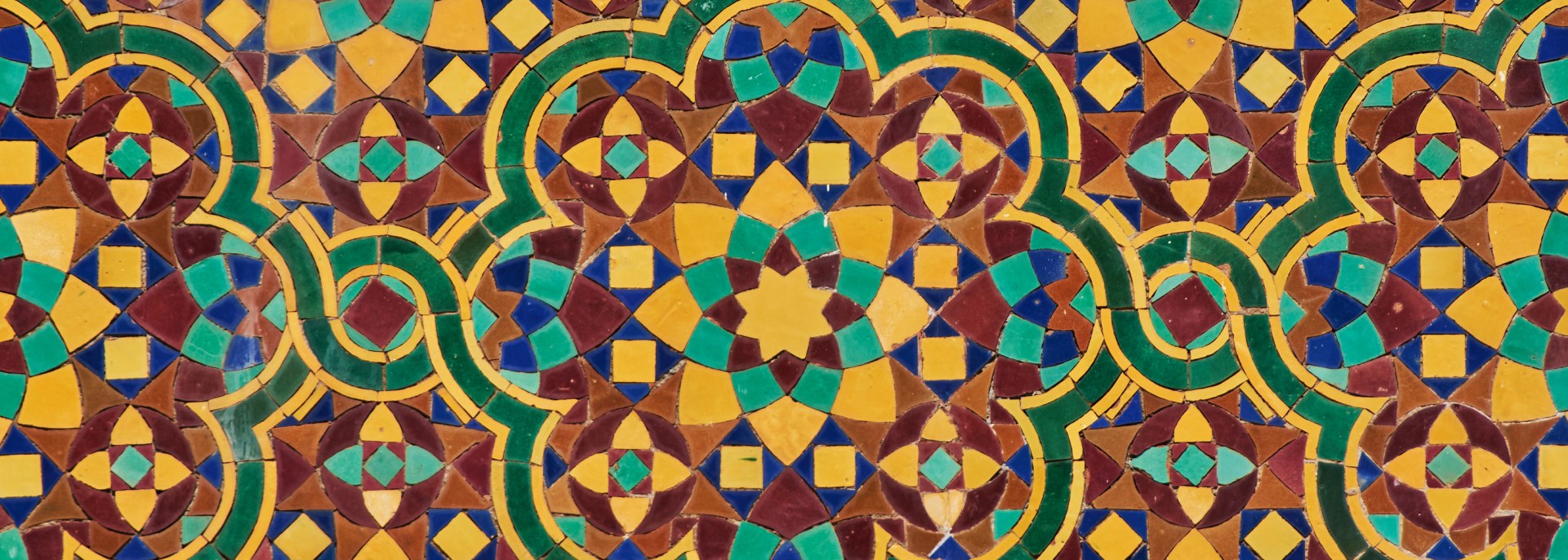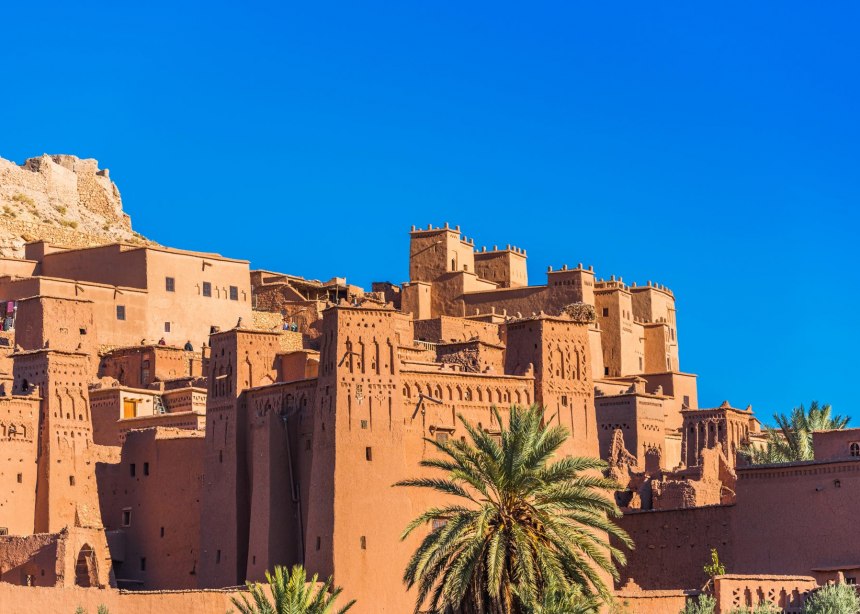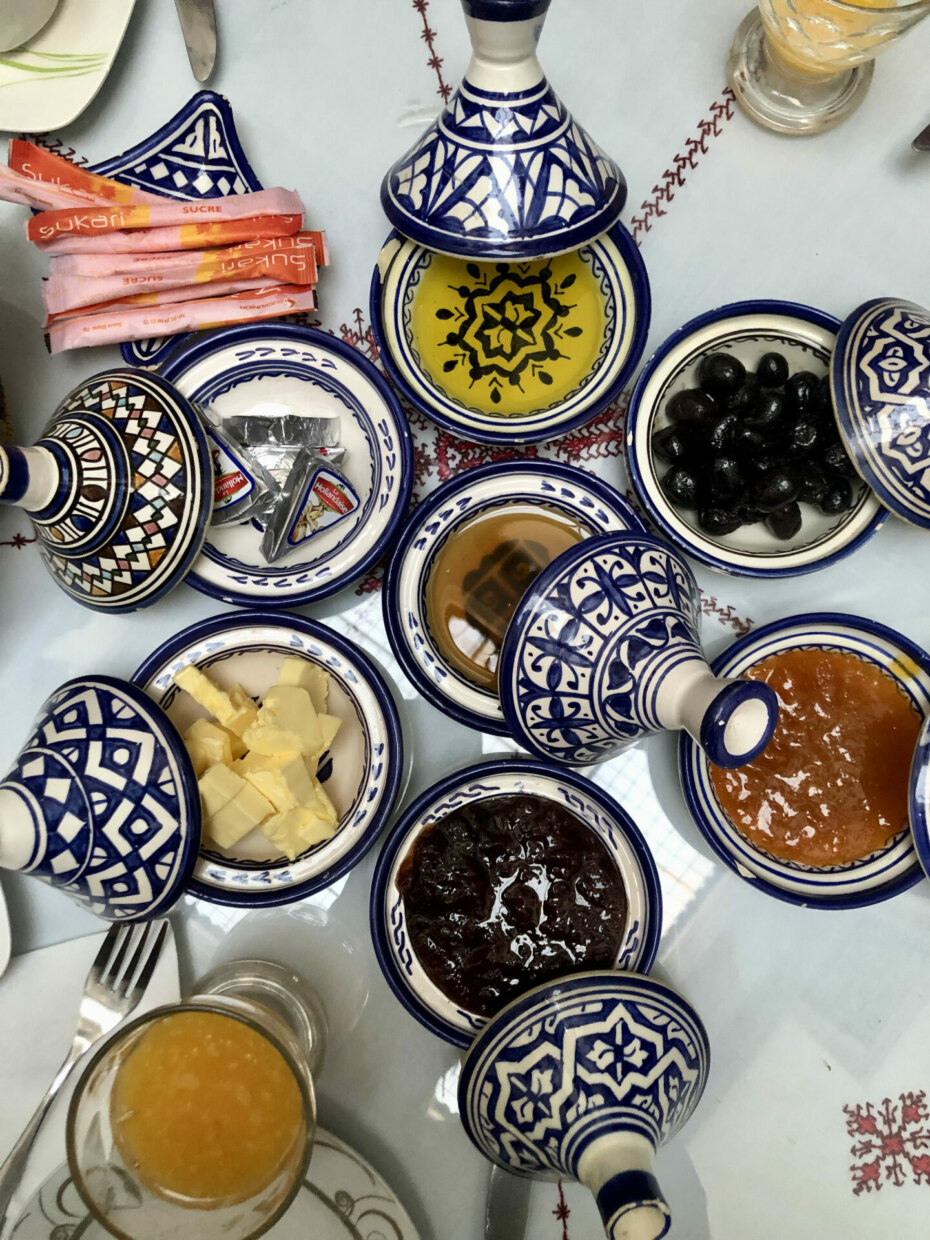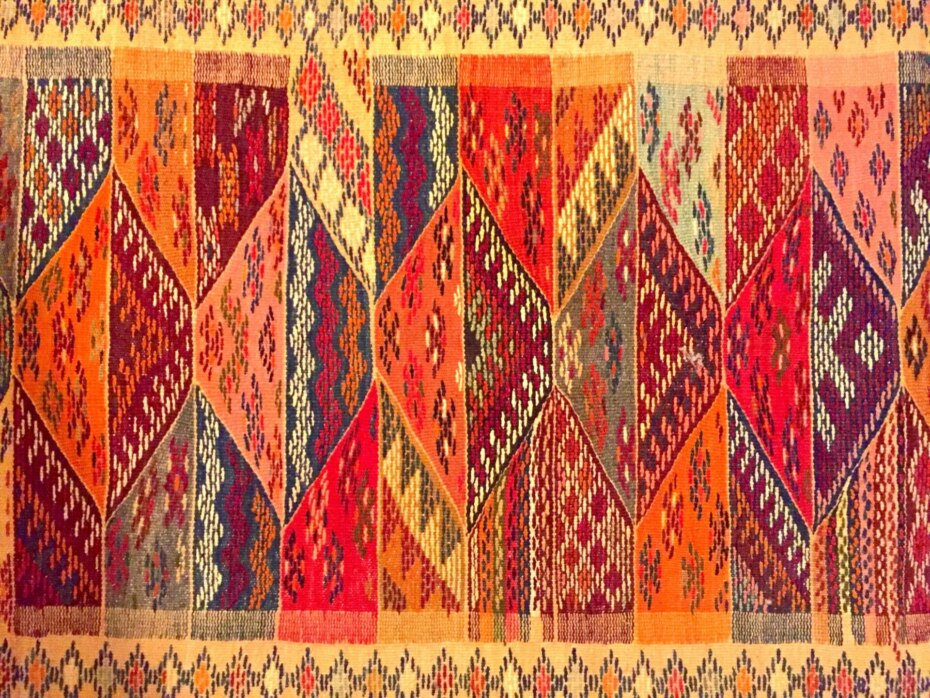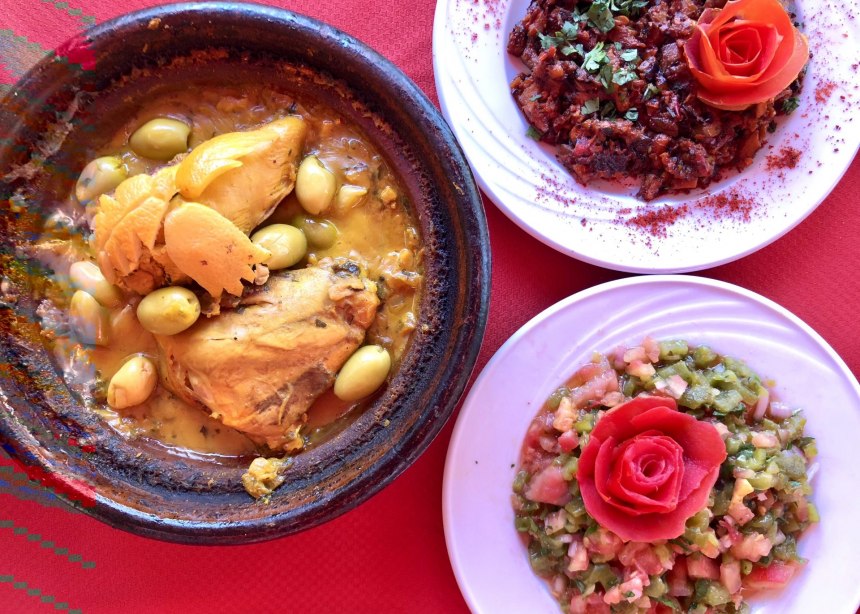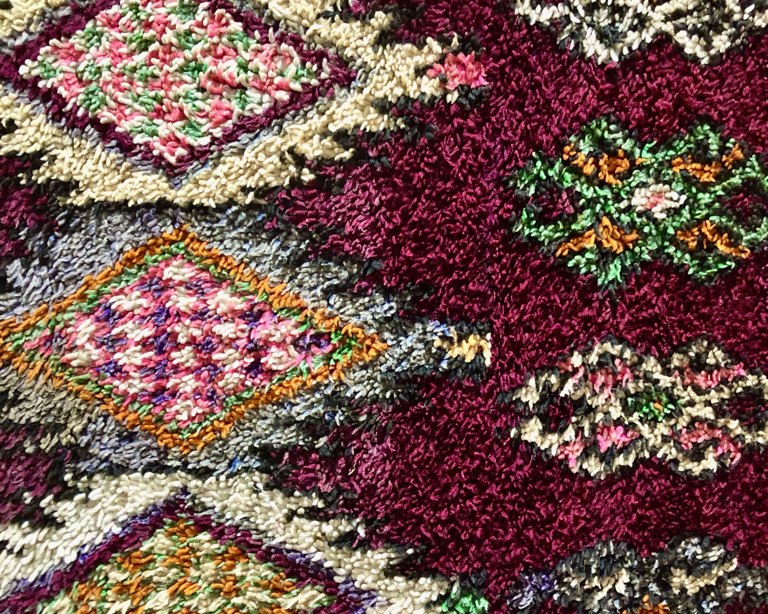These two textile tours of Morocco take you ‘Behind the Scenes’ with a small group of friendly people to share an authentic experience of Moroccan hospitality.
DATES:
February 15 – March 1, 2025 and
October 5 – 20, 2025
The itineraries are special because although we visit justifiably popular sites like Marrakech and Fes, we’ll go “off the beaten path” to spend time in remote Sahara Desert regions, home to interesting and talented Berber artisans. We’ll ride camels to our tent camp, meet desert women making rugs, join a coop to dye sheep’s wool with natural colors, watch potters make the famous green-glazed ware, and admire the date palm plantations. We will also take books in English to a high school library where we can meet the students and chat with them. Some speak excellent English and hunger for good stories to read.
Charming and comfortable hotels called riads, or kasbahs in the desert, will be our home bases. As we travel, we’ll explore the historic walled ksars, watch craftsmen at work, and poke around in the traditional little souks for treasures to take home.
TRIP HIGHLIGHTS
- 8 UNESCO World Heritage Sites including the bustling Medinas of Fes and Essaouira!
- Shop for jewelry, spices and crafts in the souks of exotic Marrakech and Fes
- Learn how tile mosaics are made for floors and walls; watch ceramics artists.
- Visit the fabulous Hassan II Mosque, at seaside Casablanca
- Ride a camel in the Sahara Desert to our glamping tent camp!
- Visit a desert Berber high school library and donate books; meet the kids!
What’s Included in The Trip?
An Overview of Your Journey
Casablanca to Marrakech
We’ll start this marvelous adventure by flying in to legendary Casablanca. The next day we’ll visit the fabulous Hassan II Mosque, at seaside Casablanca. The mosque has exquisite mosaics inside and out. We’ll have a specialized guide for our mosque visit and she’ll explain the mosque’s amazing statistics and its special features.
Next, we’ll hop in our Sprinter and drive south to fabled and friendly Marrakesh. Even today Marrakech manages to feel exotic and other-worldly, especially in the old fortified city area, called the medina, a densely packed, walled medieval city.
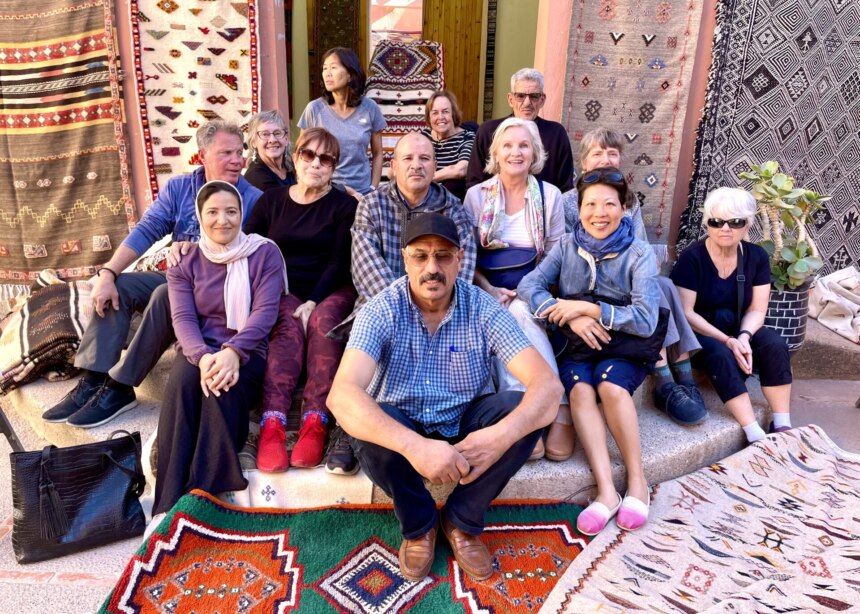
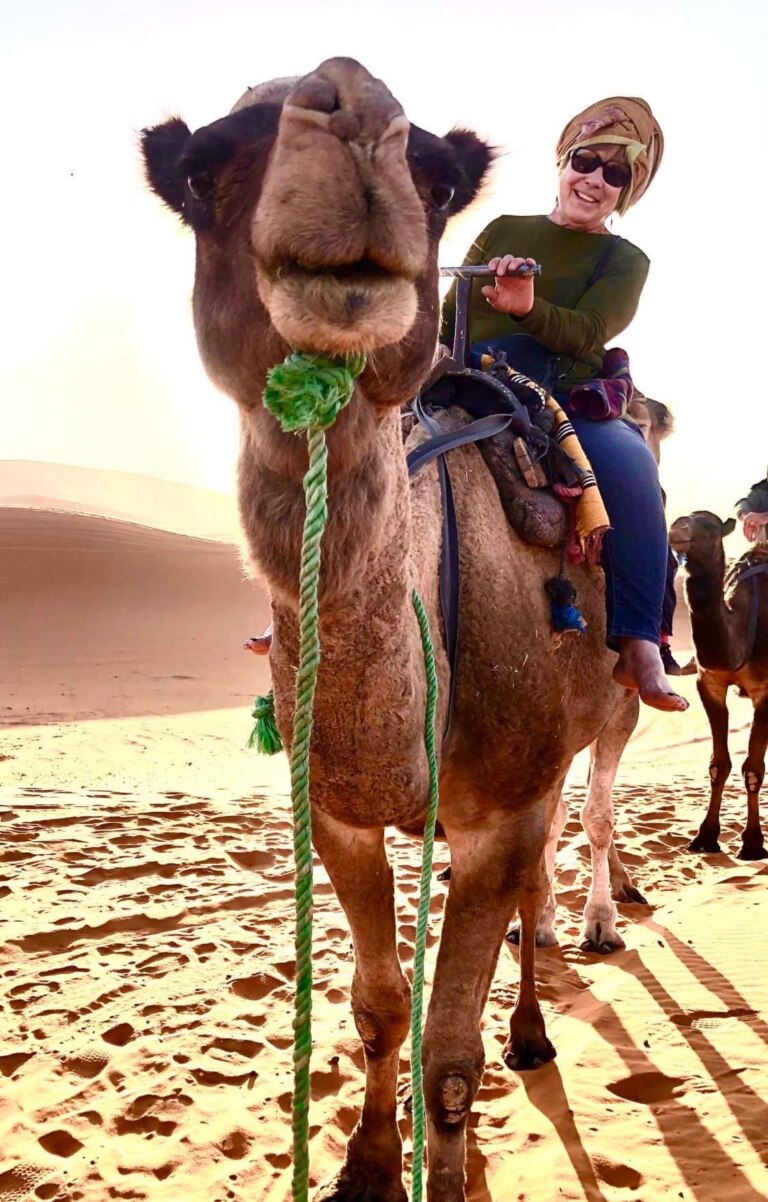
Legendary Marrakech and the Atlas Mountains
Little market shops in the Medina offer a treasure of traditional textiles, baskets, felted slippers, pottery and jewelry. Here we can meet master artisans at work, and wander the narrow, cobblestone streets of the market.
One morning in Marrakech we will have a professional cooking class. Moroccan food is divine and we’ll create delicious dishes that include your choice of either vegetable or chicken tajine, a typical, succulent stew. Everywhere we go, our guide (a bit of a foodie himself!) will show us the best places to eat, the hidden corners to visit and the most interesting artisans and friends to meet. We will also see the stunning Majorelle Gardens begun by French painter Jacques Majorelle, and the excellent museums of authentic Berber jewelry, clothing and textiles. Lunch that day will be in the pretty garden patio of the Yves Saint Laurent Museum.
Later, we’ll drive over the Atlas Mountains to Ouarzazate. One day we’ll drive south to visit a women’s coop group of traditional rug makers. They will explain the natural dyes they use for the brilliant carpet colors. Then we’ll have a natural dye workshop to tint skeins of wool yarn. We can also watch them make the beautiful rugs sold in the coop. The purchase of the excellent quality carpets made by the women helps them directly to improve their quality of life and that of their children.
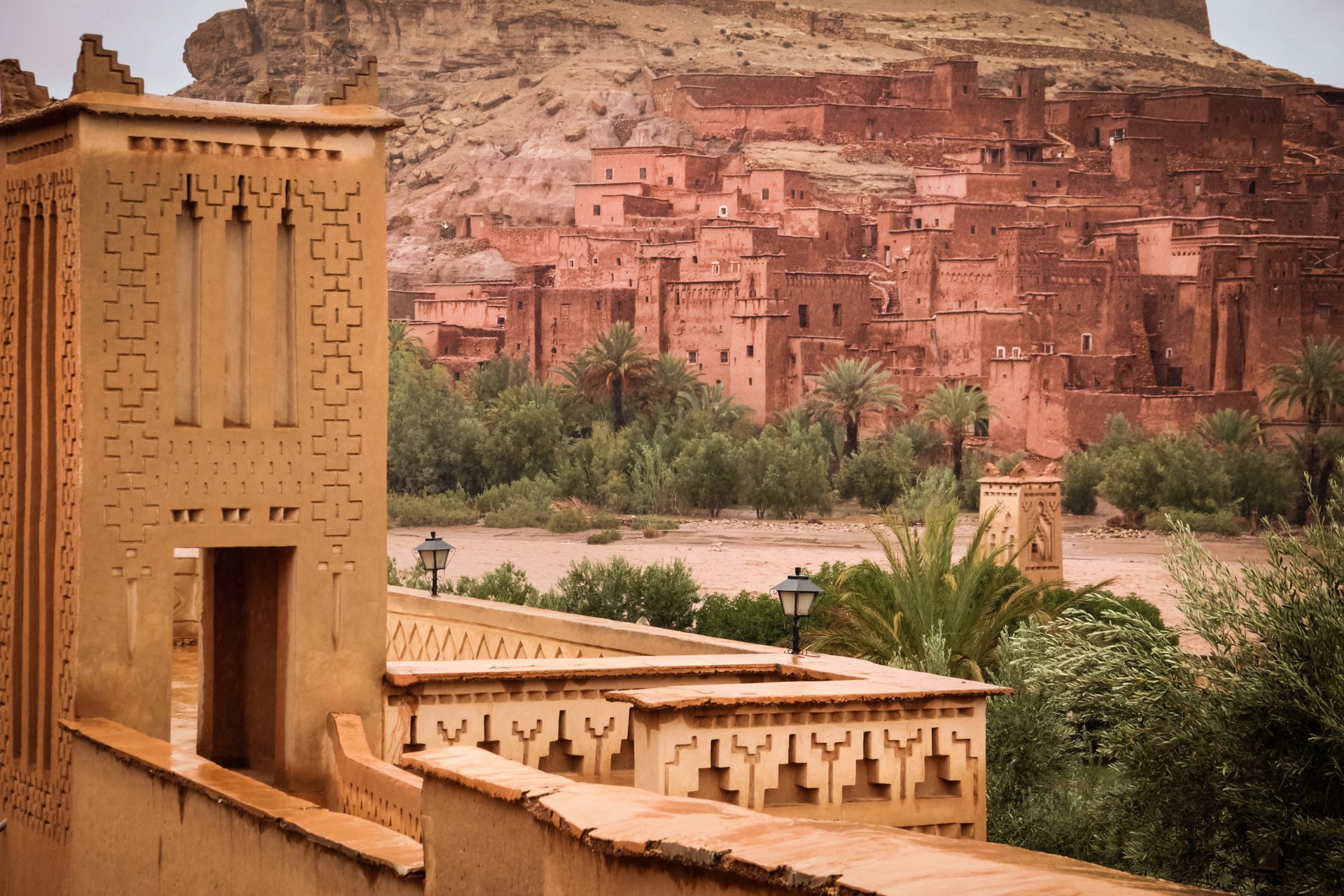
Ait Ben’Haddou UNESCO Site
Along the way, we’ll see the mystical ksar or fortified city at Ait Ben’Haddou, a spectacular complex of earthen dwellings surrounded by high defensive walls reinforced by angle towers. A UNESCO site since 1987, Ait Ben’Haddou is a striking example of southern Moroccan pre-Saharan architecture. We’ll also spend one night glamping in comfortable tents on the Saharan dunes; friendly camels will take us over the sand to the tent camp!
We’ve partnered with a California-based library project working in Morocco. We’ll visit a Berber community’s high school library, meet the students, and donate much-appreciated books in English that we have brought from home. Then we head inland to Midelt, land of fossils, geodes, and minerals. Here we’ll meet a group of women in an embroidery cooperative and see their fine creations. Next day we’ll head north to Ifrane, and on to our cozy riad in Fes.
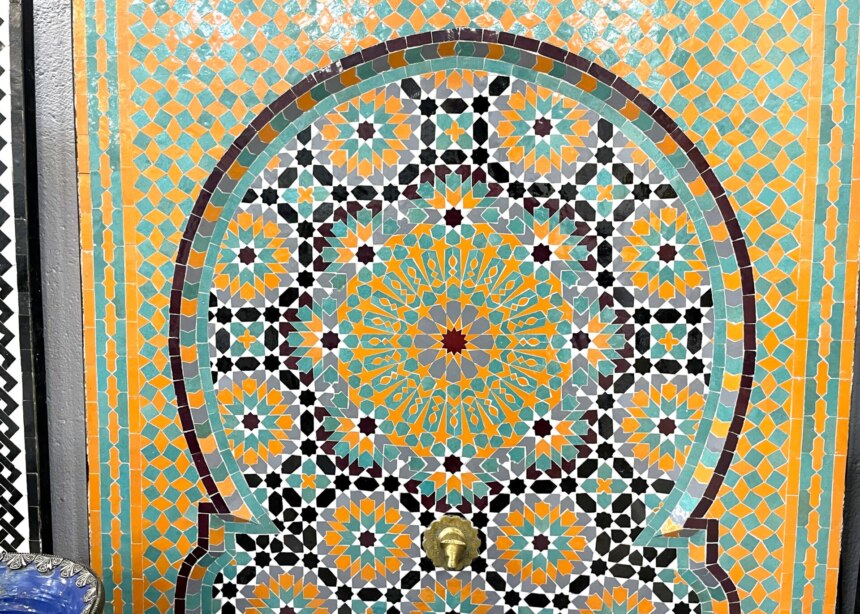
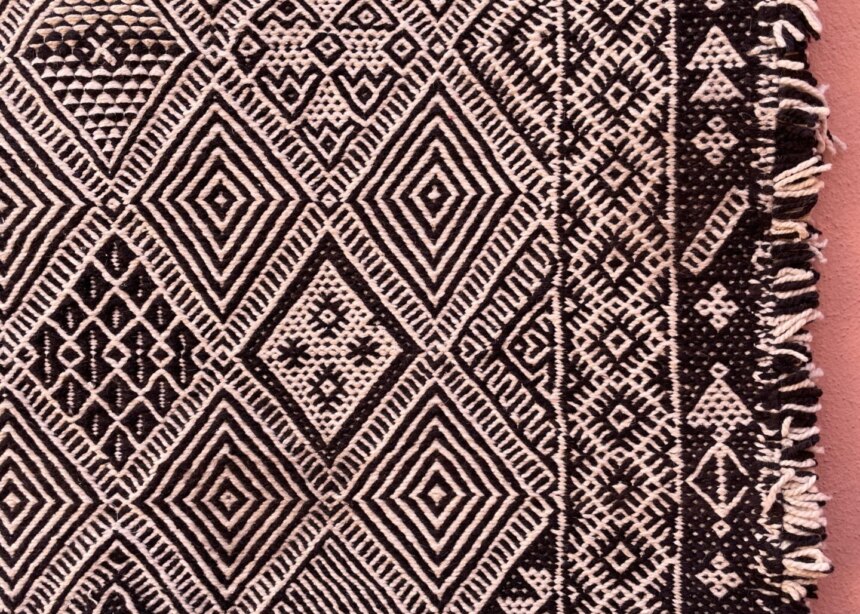
The fabulous Fes Medina
The delightful city of Fes is primarily known for its ancient sprawling medina or walled city, the best-preserved in the Arab world. It’s another UNESCO World Heritage site.
Major monuments that we will visit in Fes date to the 13th and 14th centuries. The world’s oldest university, University of Al Quaraouiyine is here too. We’ll spend several days in Fes, sleeping in a charming riad with zellij mosaic tiles, in the old medina.
Ali will explain the mosques and madrasas with their highly decorated mosaic walls. This medina is much calmer than the one in Marrakech. Craftsmen still work and sell their products here, and like others, this medina is divided into areas by trade—the leather crafters, ceram-icists, dyers, and so forth. Wander in the medina to find traditional arts of Morocco: carpets, leather slippers, brass lanterns, or antique silver jewelry.
In the medina, we’ll visit a friend who has a small shop with stacks and stacks of beautiful carpets. He and I will explain the various techniques and patterns with different examples, from different areas of the country.
Chefchaouen, the Blue City!
We’ll tour a large ceramics factory in Fes where craftspeople still hand-paint plates and vases. Other workers there paint tiles and fire them, then cut the intricate glazed tile pieces for zellij – complex mosaics composed of tiny geometric shapes – used to decorate walls, fountains and floors of mosques, madrasas and villas.
Next we drive north to the famous Blue City of Chefchaouen, to explore the azure lanes and houses. We’ll visit some weavers here on the first day, then the next day is free to wander the turquoise streets and find a new and unusual view to capture in this blue world! We’ll spend two cozy and peaceful nights, then drive south to visit the highlights of Rabat, such as the Royal Stables and the market. Then we drive a couple of hours back to Casablanca to our hotel. The rest of the day is free to pack up suitcases and/or explore the city. November 18 is our last included night of hotel. At the Farewell Dinner, we’ll take leave of old friends and new, then get a good sleep for our flights home tomorrow from Casablanca (CMN), on November 19.
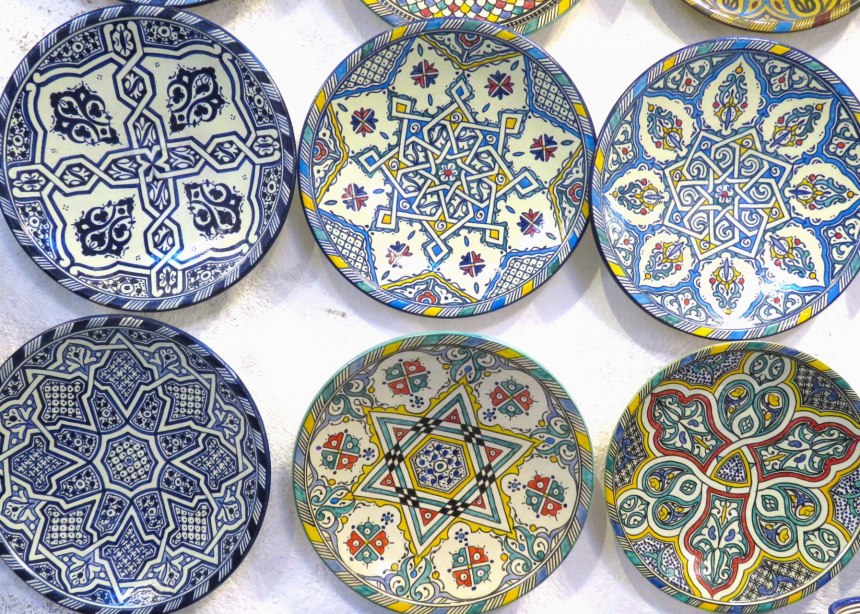
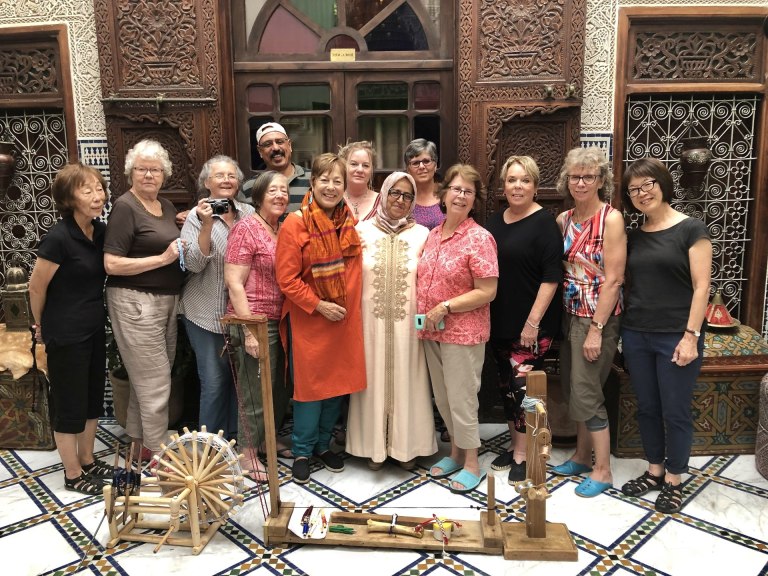
Where You Will Be Staying
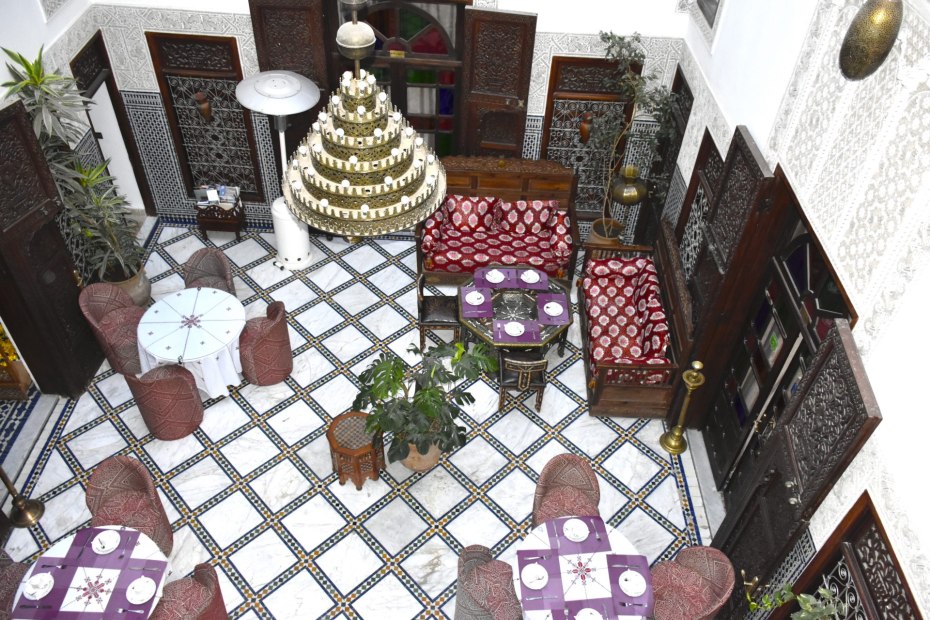
Fes Riad Chrifa
Beautifullyrenovated villa just two blocks from one of the Medina gates. Rooms are large with typical zellij mosaics and traditional furniture. Delicious breakfasts and dinner are served in the central patio. One evening we’ll have a buffet-style picnic on the rooftop terrace. From here, the view of the Medina and the evening call to prayer are especially amazing.
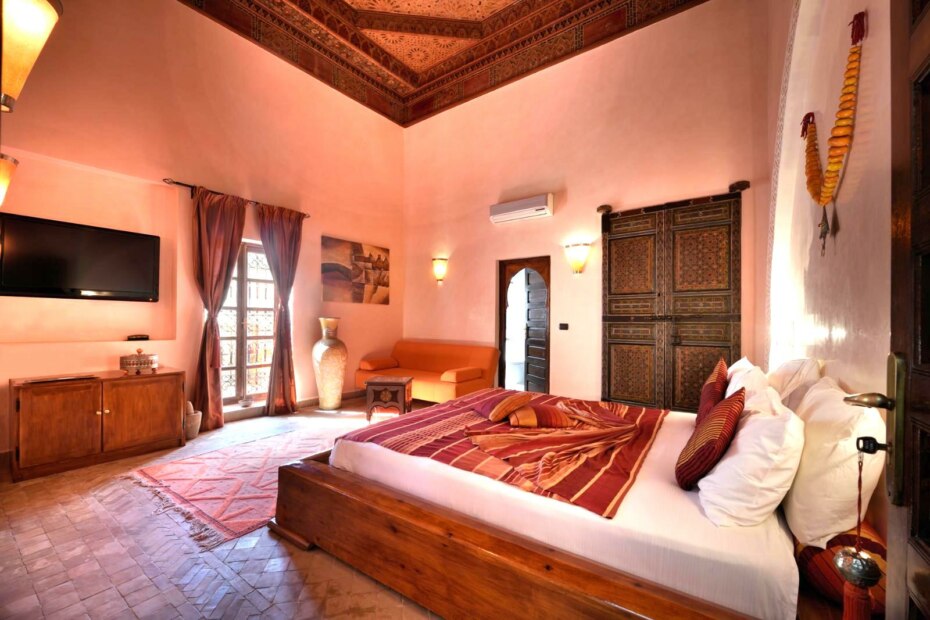
Riad Les Ammonites
A short walk into the Marrakech Medina is this charming little riad where you’ll feel right at home. Continental breakfast is served every morning and we’ll enjoy the sunset from the rooftop terrace. Traditionally decorated rooms surround a central courtyard with a small pool. Tropical trees enhance the relaxing patio downstairs.
Additional Details & Experiences
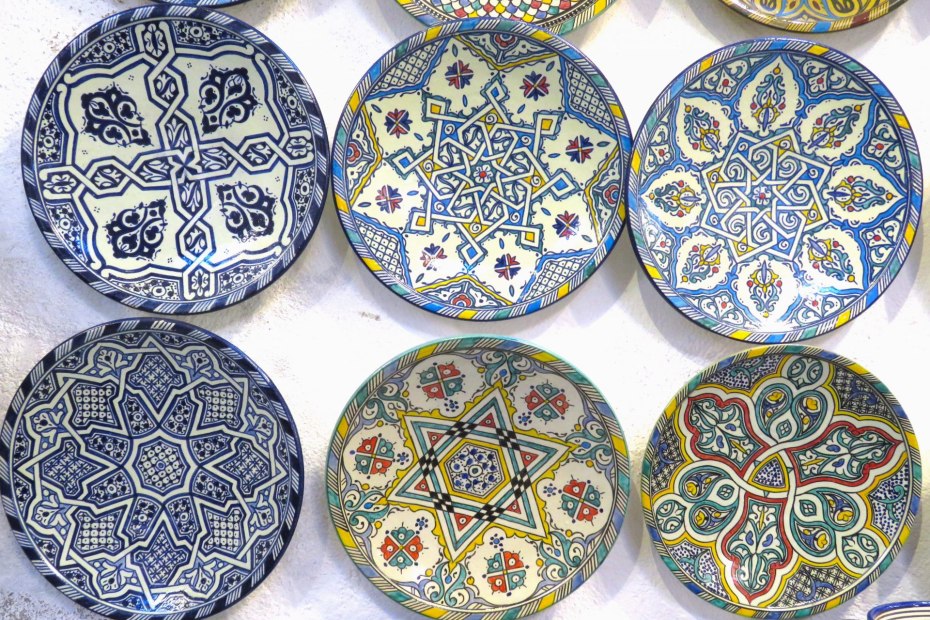
What Is There to Buy in Morocco?
There are wonderful things to bargain for and take home from Morocco. We will visit numerous artisans and can purchase arts and crafts directly from many of them. We’ll see pretty handwoven pillows and rugs in many places, but felted slippers, leather handmade slippers, ceramic plates, and unusual button-decorated caftans are also good buys. Having the memory of the woman who made your rug, or the young man who painted your beautiful cobalt blue plate makes those items so much more meaningful and precious.
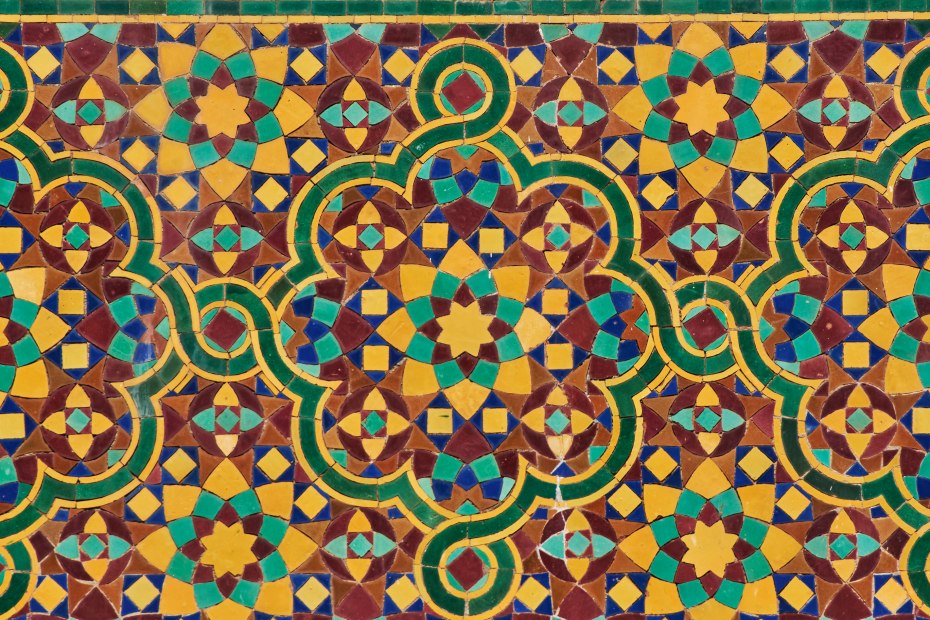
Zellij – Moroccan Mosaics
You’ll see intricate and colorful mosaics on walls and floors all over Morocco. To learn how they are made, we’ll visit a mosaic workshop, usually part of a ceramics factory. Cut from hand-made ceramic tiles and set upside down on a paper pattern, the little pieces are carefully fitted together. Then a slurry of cement binder is poured on top and soothed over neatly. When dry, the piece is turned upright to reveal the colorful patterns. Once you see how these intricate mosaics are constructed, you’ll start seeing them everywhere and appreciating them for their skill and craftsmanship.
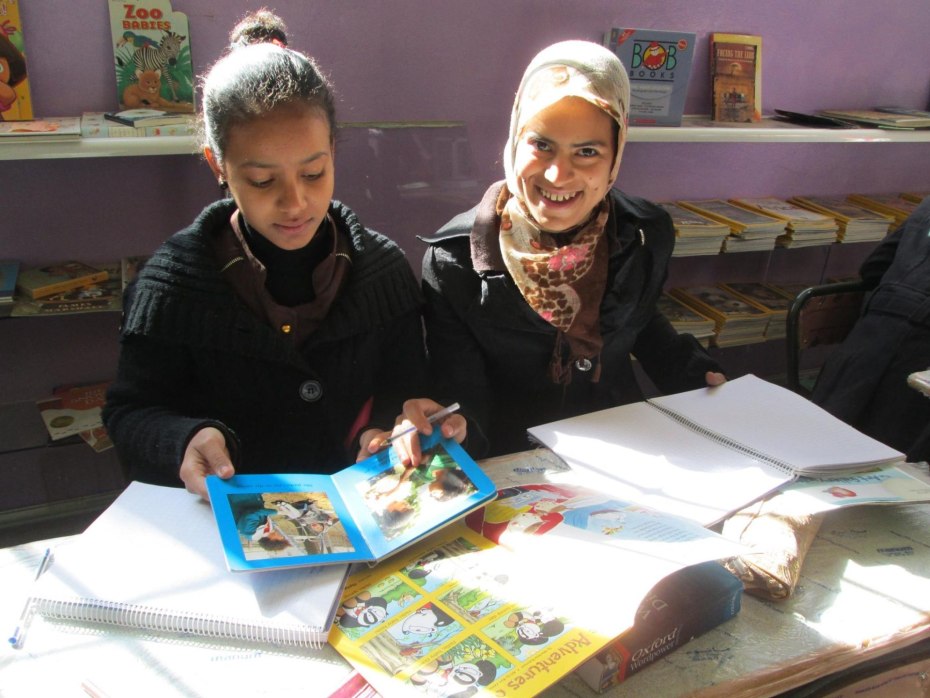
Bring Books to Donate
We hope you’ll bring some books for teens to contribute to this Olive Seed library project. Olive Seed has a list of most-read, favorite books that we will send to you for suggestions if you like. Gently used books from the thrift store or from your bookshelves are fine too! Our plan is to donate books in English to a couple of school libraries in rural areas. According to our itinerary, Barb will plan a visit for us to a school library that needs books. Students start learning English in high school and become avid readers when they have gripping stories to read.
Morocco is over the top amazing – the sights, sounds, tastes, smells, and COLORS are so intense! The Textiles and Tajines Tour is a marvelous blend of yes, textiles and tajines, but also culture, history, and architecture, with camels and goats thrown in for good measure! The trip was a wonderful well-planned experience.
Sharon B. – Minnesota
Your Trip Leaders
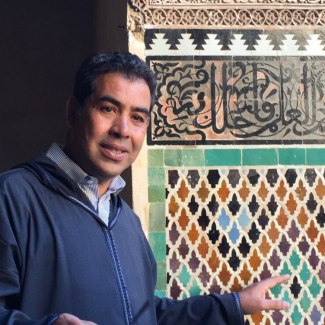
Ali
Ali is the Behind the Scenes Morocco guide par excellence! Ali will not only relate the history of Morocco, but amuse you with his take on all aspects of his culture, from the King to marriage customs, culinary traditions, etiquette, and more. On every trip, Ali discovers more textile techniques and artisans’ workshops, and encourages the working masters to give demos for the Behind the Scenes Adventures groups. Ali speaks French, Arabic and English, due to his decades of guide experience. He knows where to find the best djellabas and carpets, the sweetest dates and the crispest b’stilla.
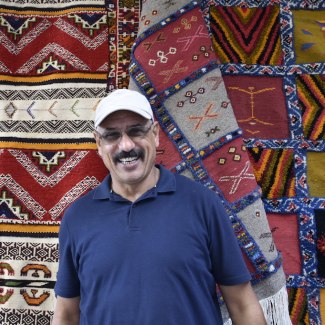
Abdel
Abdel is the best driver! While skillfully navigating the Sprinter in Casablanca traffic, calmly dodging rude drivers, and agreeing to umpteen bathroom stops, Abdel never stops smiling. Nothing is ever too much trouble for him. He happily joins the group to help out whenever he can. He has even ridden camels in the desert with us, definitely not in his job description!
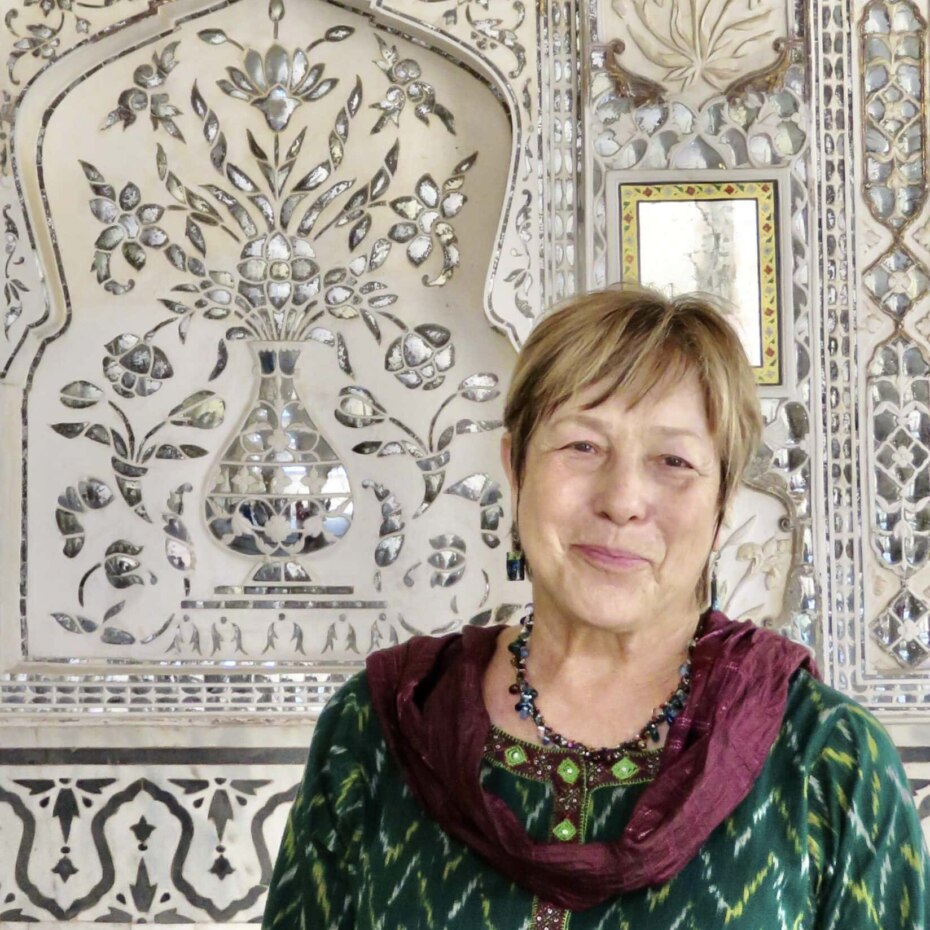
Cynthia
Cynthia began “Behind the Scenes Adventures” to share with others the traditional textiles and festivals of far-flung countries. Since 1998 she has led small groups of textile fanatics and friends all over the world. She accompanies all the tours for her “woman-owned” business. Desiring some new locations and new types of textiles, she has branched out in recent years to discover many other wonderful destinations for Behind the Scenes tours.
Check Trip Availability
Trip signups are accepted on a first-come, first serve basis. Please provide your details below and we’ll be in touch to confirm whether spaces are still available for this trip. If you need to get in contact, please email: info@btsadventures.com
Registration Information
- Dates: February 15 – March 1, 2025
- Fly Home Date: March 2, 2025
- Deposit: $500
- Tour Cost: 16 Nights From $6125
- Single Supplement: $995
For more information:
Phone: 707-939-8874
E-mail: info@btsadventures.com
Read: Frequently Asked Questions
Travel Plans
You will be flying in and out of Casablanca (CMN airport code), arriving on November 3 and departing on November 19. (Note that November 18 is the last included night of hotel for this 16-night trip.)
You can search for a plane ticket on Orbitz.com or Expedia.com or you can contact your favorite travel agent for a ticket.
The United States no longer requires a negative COIVD test for returning home from abroad. And immigration officials in Morocco no longer want to see your vaccination cards.
Visas
Visa Information for Morocco:
A tourist visa is not required for stays of less than 90 days for citizens of most countries, such as USA, UK, Australia, Canada, etc. Check for current info for your country on the Morocco Embassy website.
When we arrive at the Casablanca CMN airport, the Immigration officials will stamp our passports with an entry date.
Passport Validity:
Your passport must have at least six months of validity at time of entry. You need one blank passport page for the Morocco entry stamp.
What’s Included
- 16 nights accommodations (November 3 -18) (double occupancy), in charmingly decorated riads (small private villas with central courtyards), and very good modern hotel in Casablanca)
- All meals and non-alcoholic beverages.
- All ground transportation by private Sprinter van with excellent, professional driver
- Bottled water in the van for all road trips
- Transportation to/from airport on official arrival and departure dates
- English- and French/Arabic-speaking easy-going and professional guide to accompany the tour
- French – and English-speaking textile expert Cynthia Samaké also accompanies the itinerary
- A cooking class in Marrakesh to learn gourmet cuisine; eat our delicious dishes for lunch
- Entrance to all historical sights, museums, etc., on the itinerary
What’s Not Included
- Personal items/laundry
- Visits to sites or activities not on the itinerary
- Between-meal snacks and bottled water when not in the van. (It’s rare that anyone needs extra food; our meals are typically very generous.)
- Early arrival/late departure (on a different date) airport transport is extra ($55 for 1-5 people and $75 for 6-10 people)
Frequently Asked Questions
General Questions
What information will I receive after registering?
Once you sign up for a trip, we will e-mail a general itinerary, lists of Suggested Reading, what to take, cultural considerations, weather charts, etc.
How can I get a detailed itinerary for a tour?
A day-to-day itinerary will be sent once you sign up for a trip. If you need specific information about the flow of the trip and the pace of the specific activities, before committing to the trip, get in touch with your questions and we will be happy to fill you in.
What sort of clothing should I bring?
When you sign up for a tour, you’ll receive detailed lists of what to bring to your destination, as well as weather info, to more easily coordinate your wardrobe with the heat or cold.
We will also include suggestions for appropriate clothing for dressing in conservative countries. Basically, you’ll need modest clothes that cover your shoulders and legs. Being well-dressed will show the locals that we respect them and their society.
Are laundry services available?
Most hotels have a laundry service and prefer that you don’t wash clothes in the bathroom sinks. If there is no laundry service, and you don’t want to wash your jeans and wait a day or two for them to dry, asking at the hotel desk is a good place to start.
Please note that it is considered demeaning to wash someone else’s underpants, so we ask that you wash your own underpants. Hang them to dry discreetly in the bathroom.
Are laundry services available?
Most hotels have a laundry service and prefer that you don’t wash clothes in the bathroom sinks. If there is no laundry service, and you don’t want to wash your jeans and wait a day or two for them to dry, asking at the hotel desk is a good place to start.
Please note that it is considered demeaning to wash someone else’s underpants, so we ask that you wash your own underpants. Hang them to dry discreetly in the bathroom.
Are laundry services available?
Most hotels have a laundry service and prefer that you don’t wash clothes in the bathroom sinks. If there is no laundry service, and you don’t want to wash your jeans and wait a day or two for them to dry, asking at the hotel desk is a good place to start.
Please note that it is considered demeaning to wash someone else’s underpants, so we ask that you wash your own underpants. Hang them to dry discreetly in the bathroom.
Do I need any vaccinations or immunizations?
This varies with each country. Make an appointment with your travel doctor and take your tour itinerary with you. Some areas of certain countries require malaria pills and others do not; same with Yellow Fever and others such as Cholera and Typhoid. He or she will have all the latest requirements at hand.
A rural visit to a farm may require extra precautions, for example. We will send you the links to the CDC.gov information pages for your specific destination so that you can ask questions.
You should be current on all your typical childhood and international travel shots such as Polio and Tetanus. Some countries now demand proof of vaccination against COVID. Behind the Scenes Adventures requires you to have had two COVID vaccinations. We recommend you have a booster as well.
How much physical activity is involved during the trip?
Each trip has different activity levels that will be fully explained in the specific tour material. But no activities or events are mandatory, and you are always welcome to sit at the bottom of the stairs to a temple or wait in the van while others ascend or visit a particular place. Walking sticks are fine to bring if they help you. We cannot accept wheelchairs or walkers.
For most tours, you’ll need to be able to walk the distance of 4-5 city blocks on your own, with sturdy shoes. Please note that sidewalks in many countries are full of big holes and broken cement chunks, with bits of re-bar sticking out, and you must constantly be alert to these dangers. In urban areas where distances are greater, the group will take taxis and/or get help from local assistants. If you need a personal taxi or additional special aid, that will be at your expense.
What will the weather be like?
Our Morocco trips are planned for temperate weather with little or no rain, in the spring months of March to June, and fall (September-November). During these seasons, the weather is warm but pleasant, unlike the freezing cold of winter. The summer temperatures of July and August are far too hot, especially in the desert areas. During our trips, average daytime temperatures are usually in the 60s and to high 70s, and nights can be cooler, in the 50s, bring layers! The coastal regions like Essaouira can be visited year-round. Temperatures are much harder to predict, but we will send Weather Charts with your pre-departure info.
Meals & Accommodations
What sort of food will we be eating?
Moroccan cooking abounds with subtle spices and intriguing flavor combinations. Think tart green olives paired with preserved lemon rind in a tagine of tender chicken or the surprise of rich chicken pie dusted with cinnamon and powdered sugar (called b’stilla), soups, or many different chopped, vegetables – raw or cooked – made into delicious salads. Fresh bread is always plentiful too.
We will send out lists and information about traditional Moroccan cuisine. And we will have two cooking classes where you can choose to prepare exactly what you prefer to eat!
The guide will sometimes choose a variety of typical dishes to share around the table, so we can taste many different combinations and find our favorites. Then when possible, you can order what you like from the menu. The portions are huge, and we have never had anyone leave the restaurant table hungry! Some restaurants don’t have menus but have a specialty that everyone receives. This is definitely the case when we have lunch with a family of weavers and we are served Family Style.
Will I be able to accommodate my dietary needs?
If you have any special dietary, health, or nutrition issues, restrictions, etc, there is no guarantee that Behind the Scenes Adventures will be able to accommodate your special diets in foreign countries. Please contact us before departure, and bring sufficient alternative foods. Travelers with severe peanut allergies cannot be accepted. Vegan diets are possible but with much less variety than at home. Vegetarian diets are often fairly easy to accommodate, but also with less variety than what is available at home.
Flights & Travel
Will I need a visa for connecting countries?
It is very rare to need a visa for a connection if you stay in the Transit area. This will be regulated by the connecting country and the airline will send information as to this requirement.
What are the requirements for my passport to be valid?
Your passport needs to have one blank page for your visa, although, with an E-Visa, you will have just a piece of paper to show, and don’t need room for anything except Immigration stamps in your passport.
Your passport must remain valid (not expired) for 6 months after you enter each country.
Will I be met at the airport?
Yes! Cynthia, an assistant or a driver will meet you with a sign with your name and/or Behind the Scenes Adventures. They will have your flight schedule and know you will need time to pick up your luggage. Wait for them in the terminal, right outside the Arrivals area, and don’t go with any other drivers that don’t have your name on a placard.
What is the best airline to fly to the country?
We’ll send you some suggestions for airlines as departure flight info becomes available. You can search for a plane ticket on Orbitz.com or Expedia.com or you can contact your favorite travel agent for a ticket.
What will we use for transportation?
We use a new Mercedes Sprinter for most interior transportation. It is high-topped and spacious, and our luggage is stored in the back, or on top if we amass extra bags along the way. (This is another reason we must start with a luggage limit; see list of What to Take for luggage limits.)
